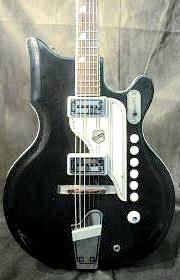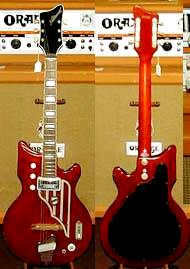Vintage Guitars Info's
National Resonator and
National/Valco Map-shaped
Electric Vintage Guitar Info.
National resonator and National/Valco electric map shaped vintage guitars history and collecting. Private vintage guitar collector. Pictures, history for National resonator vintage guitars.
Contact the Vintage Guitar Info Guy.
1928 National Tricone
style 1 squareneck
Introduction and Serial Numbers:
- National Resonator Introduction
(the different resonator systems and how they work and sound) - National Guitar Collectibility
- National Map Shaped Guitar Introduction
- Buying a National Guitar
- New National Guitars
- 1927-1941 National Resonator Serial Numbers (How to Find the Year)
- 1941-1968 National/Valco Serial Numbers
(including National, Valco, Supro instruments) - Picture Gallery, National section
1927-1941 National Resonator Model Info:
- Tricone models. Silver resonator metalbody, round and squareneck vintage models. Includes the Style 1, 1 1/2 ,2, 2 1/2, 3, 4, 35, 97 nickel plated models, and the style M-3 painted tricones.
- Style O silver resonator vintage metalbody
- Style N silver resonator vintage metalbody
- The Don silver resonator vintage metalbody
- Duolian resonator vintage metalbody
- Triolian resonator vintage metalbody
- Supro Collegian resonator vintage metalbody
- Wood Body Resonator Models including Triolian, Trojan, Estralita, El Trovador, Rosita, Aragon, Havana.
- Ukuleles resonator vintage metalbody
1962-1965 National/Valco Map-shaped Electric Models:
- Warning on these Models
- Glenwood 99
- Glenwood 98
- Glenwood 95
- Val-Pro 88, Newport 88
- Val-Pro 84, Newport 84
- Val-Pro 82, Newport 82
- Westwood 77
- Westwood 75
- Westwood 72
National Resonator Introduction.
-
National resonator instruments made from 1928 to 1940 were louder than
conventional acoustic guitars of the era. They were also very popular with
Hawaiian and Blues musicians in the late 1920's and early 1930's.
National's two types of resonators:
The single cone and the tricone.
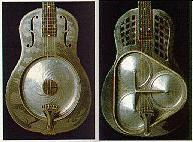
National made two types of resonator instruments: tricone and single cone models. Tricone instruments have a very sweet and warm tone. This is due to their long decay (sustain) and slight attack. Single cone Nationals are slightly louder than Tricones, and have a sharp (loud) attack with short decay (sustain). Because of this, single cone Nationals sound much like a banjo. Which type of resonator you like may depend on what style of music you like. Many blues players feel the combination of single cone resonator, steel body, and mahogany neck used on the Duolian is the ultimate Blues guitar. The fancier nickel plated brass, single cone metalbody instruments such as the Style O don't have as bluesy a tone as the less ornate Duolian. This is attributed to their brass, not steel, body material. But they sure do look great! Personally, I feel the Tricone's smoother, more complex tone is the best National sound and look! A roundneck tricone (in my opinion) is the ultimate resonator guitar.
-
National resonator instruments use very thin aluminum speaker cones,
known as "cones", to mechanically amplify the sound of the
instrument. This style of mechanical amplification was invented
in the 1920's, before the advent of electric instruments.
At the time of their invention, they were considered the loudest
guitar available. Some National models have a single cone,
others have three smaller cones (known as "tricones" or "triplates").
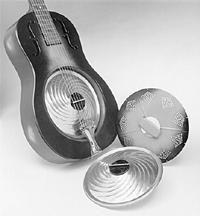
-
In the single resonator models the convex 9.5" diameter
cone has a maple "biscuit" on top of the cone. The biscuit has a
wooden maple saddle which the strings pass over, like a
conventional acoustic flat top guitar.
But unlike flattop acoustic guitars where the
vibration of the wooden body creates the sound, in a
National resonator instrument the body acts as a speaker cabinet.
When the strings are played, the vibration goes through the
saddle to the bridge and then vibrates the speaker cone
causing it to "resonate" and amplify the sound. Because
there is fairly direct transmission of vibration from the strings
to the resonator, the single resonator guitar is the loudest of
the resonator guitars.
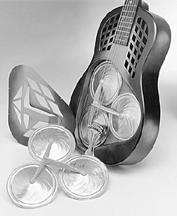
In a tricone, the three 6" cones are set in a triangle. Two of the cones are on the bass side, and one on the treble side. Rather than a wooden biscuit bridge, there is an aluminum "T" shaped bridge that connects to the center of each of the cones. A maple wooden saddle sits atop the T-bridge. The vibration from the strings goes through the saddle, which in turn vibrates the T-bridge, and then the three cones. The sound has farther to travel to get the cones resonating than with a single resonator guitar. Thus, that's why tricones are not as loud on the attack. However the sustain is greater, and the tone "sweeter". This is because there are three cones all vibrating together, producing more harmonics than a single resonator guitar.
1934 Duolian, 1936 Estralida, 1934 Style O (or Tricone s1/s2), reissue decal.

Vintage National Resonator Collectibility.
-
As for collectibility, nickel plated Nationals are the most collectible,
due just to the "look" of the bright nickel plating. Beyond that,
all the Tricone models are collectable, with the
fancier styles 2,3 and 4 (all engraved) being more collectible than the
plain style 1 Tricone. Be aware that almost all Tricone models came with
either a "squareneck" or a "roundneck" (and the necks are not
interchangable). This refers to the shape of the
back of the neck. Squareneck models can not be played like a
standard guitar. They are only usable for Hawaiian or Country styles.
Hence the roundneck Tricones are more versatile instruments.
Squareneck tricone models are still sought by some
Hawaiian-style players. But note Country-style players all seem to prefer
wood body Dobro models, not Nationals.
Hence wood body National resonator models have limitied
appeal and are not nearly as valuable as a metal body Nationals. And
square neck Nationals also have little collectibility compared to
round neck models. So the most collectible Nationals will always
be metal body, round neck models.
-
Another consideration with Nationals is the number of frets clear of the
body. What this means is, how many frets are accessible for playing before
you run out of neck and hit the body. Prior to late 1934, all Nationals had
12 frets clear of the body. In late 1934, National shortened the body of
their single cone instruments to give 14 frets clear of the body
(note all Tricones stayed at 12 frets clear and were never upgraded).
All guitar manufacturers during
the early to mid-1930's made this switch in design.
Left: Straight cut "f" holes on a 1929 Triolian.
Right: Rolled "f" holes on a 1934 Sytle O.
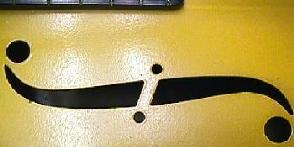
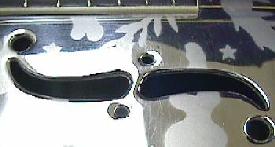
Resonator Single Cone Sound Differences: 12 versus 14 Frets.
-
The sound of 12 fret and 14 fret National single cones is different. Twelve
fret instruments are a little louder since the body is bigger. The "best"
generation of 12 fret single cone metal-body Nationals is the 1933 to late
1934 varieties with "rolled" F-holes. Prior to 1933, National straight-cut
the F-holes in the single cone metal bodies.
Starting in 1933, National rolled the edges of the F-holes
making the body stiffer. The stiffer body forces the vibrations to the
resonator instead of being absorbed by the body, hence giving better tone.
When National switched to a 14 fret neck, all they did was to
shorten the body, making it smaller. This made the body even stiffer, but
also decreased the size of the body. Hence 14 fret instruments sound and look
more "compact". But on the other hand, 14 fret instruments are more
playable. It's a trade-off. Personally, I like the early 14 fret varieties
with slotted pegheads (pre-1936) as a good balance between playability,
looks, and sound. I also like the 1933 to late 1934 twelve fret, rolled
F-hole models too, but then do seem less playable because of the 12 fret
neck. The pre-1933 single cone models seem very crude to me. Also, when
National switched to 14 fret necks they changed to a 10 inch fingerboard
radius. Prior to this, most 12 fret necks have a completely
flat fingerboard radius (except for some 1934 twelve fret models).
This is very uncomfortable to me (though if you
play bottleneck this makes little difference).
is a "sandwhich"; first the fingerboard, than a middle
stiffening layer (about the same thickness as the fingerboard),
and then the bulk of the neck. National started doing
this technique in 1934 when they introduced 14 fret necks.
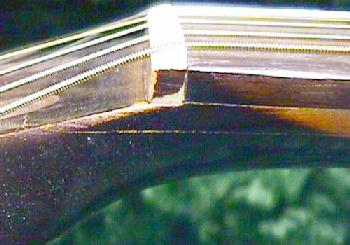
Other Vintage National Models and their Collectibility.
-
Post-WWII resonator models, with semi-solid wood or hollow fiberglass
construction have some collectability. This is because
of their unique design and sound. But they bring even less than wood body
resonator models from the pre-war period.
style 2 squareneck
-
Some of the archtop models are interesting for historic
reasons, but they are not considered collectable.
Flat top postwar models with Gibson bodies have some appeal, primarily due to their Gibson construction.
National ukuleles are very collectable. If you have one for sale, contact me immediately for more details.
National Resophonic is back in business as of 1989 producing wood and metalbody resonator guitars.
National/Valco Map Shaped Electric Guitars.
-
Most collectors are first attracted to these map-shaped electric guitars
by the way they look. The body shape
resembles a map of the United States. Introduced in late 1961 (but not available
until 1962) and were made only to 1965. For the most part, these
guitars are inexpensive, low-end models. But they have an undeniable
"cool" about them, due to their unique shape.
The res-o-glass versions of these guitars (the Val-Pro/Newport models) had their guitar's finish first sprayed into a mold, and was then sprayed with Fiberglass. The two pieces (front and back) were screwed together with five screws entering from the back and going into blocks of maple glued to the inside of the body. Valco called the material Res-O-Glas, which was a combination of polyester resin and glass threads.
All three model lines (Glenwood, Val-Pro/Newport, Westwood) had basically three models. Each model only varied in color and number of pickups/knobs.
The "standard" pickup appears to be a humbucker at first look. But really it is actually a single coil design, but smaller and less powerful than Valco's other pickup designs. Pieces of maple run from the neck joint to the endpin on both the top and back inside of the body. This stiffens the body and provides bracing for the bridge, pickup, tailpiece.
The 3-way tone switch on the single pickup models operates in similar fashion to that of a Gretsch Tennessean. In the first position, the treble is turned off. The second position has the treble full on. And in the third position, the bass is turned off. There are three volume knobs, one for each tone setting, and a master volume.
The three pickup models use the 3-way tone switch as a pickup selector (rhythm pickup, lead pickup, built-into-the-bridge transducer). This is similar to a Stratocaster's selector switch. For each position, there is a tone control (next to the switch) and a volume control (below the pickguard). The master volume is located next to the jack and tailpiece on 1964 models.
The sleek, space-age look of these guitars is enhanced by brightly colored finishes. The pearloid-and-abalone fingerboard inlay used on the Glenwoods is what Valco called its "butterfly pearl" pattern.
The "standard" pickups on these models have a midrangey throaty sound, well-suited to slide playing. The models with a built-into-the-bridge pickup, have a bluesier, twangy sound with more treble. This bridge pickup is close to a Fender sound, but without the sustain.
-
Lots of people ask for advice when buying a vintage National
resonator. So here's how I see these models, and what I would buy.
six string National resonator guitars.
This tailpiece is gold only because the rest
of the guitar is gold (normally the tailpiece
is nickel plated). You can also see
the "biscuit" bridge under the metal
coverplate. This color was extremely rare,
but shows the typical "frosted Duco" krinkle
type finish as used on most Duolians, but in
a shade of gray to dark green.
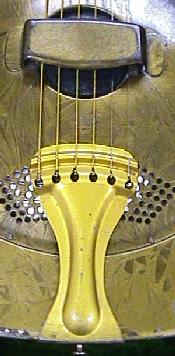
-
If money and rarity was NOT an issue, there is only one choice; a vintage
1928 to 1941 National Tricone roundneck. These are simply the best sounding
resonator guitar bar-none (regardless of era or brand or model). Their
sophisticated sound is simply amazing. The style doesn't really matter;
the plain Style 1 sounds no different than the engraved Style 4 (though
some claim the plainer Style 1's do sound better because the body is stiffer).
Second place would go the the 1934 to 1936 vintage "Don" single cone models. With a german silver body and a single cone resonator, these are great guitars. Also the 1932 to 1932 vintage Style N is right up there too (essentially the same guitar but with a 12 fret neck).
Of course this is the real world, and money and rarity DO matter. With that in mind, nothing can beat the a vintage 1929 to 1940 Duolian. At $500 to $1500 (depending on condition, originality and playability), not much can beat these. I personally like the 1934 to 1935 vintage Duolians with 14 fret necks and open pegheads.
-
But vintage Nationals aren't for everyone. You have to be careful
when buying one, especially the low-cost Duolians. Warped necks and
bad neck sets are common, and expensive to repair. A warped neck on
a Duolian will require the fingerboard to be removed, the neck straightened,
a truss rod installed, the fingerboard re-attached, a fret job,
and the neck re-set. An easy $500 or more repair.
-
As mentioned above, vintage National resonators aren't for everyone.
Vintage Nationals are peculiar, and you have to know what to look for.
NEW National resonators have become very popular. They
have adjustable necks and sound great. One of the best sounding new National
is the "polychrome" tricones. With a steel body and three resonators,
these are great guitars. But they are the butt-ugliest things in the world
though (what's up with that new "krinkle" finish"?).
If you can't get over their looks, the new nickel plated brass body Style 1 and 1.5
are great new Nationals, that look AMAZING and sound great (though they
don't sound as good as the new steel body "polychrome" triplate).
A lot of people ask me how good the new reissue Nationals are. I have to admit, they are damn good. And I'm not the only one that feels this way. Since the late 1980's when National was reformed and back in business, their instruments have gotten better and better. At first, when they were only making wood body models, and I wasn't very impressed. But now that they are making metal body single cone and tricone models, their feel and look has much improved (the sound of their reissues has always been excellent). They've improved so much that the reissues have actually caused the vintage National market to flatten. Prices for vintage 1930's Nationals has actually dropped in the past two years because demand for the originals has fallen so dramatically. This has especially been the case for vintage Tricones. This is probably due to the fact that the vintage tricones were much more expensive than vintage single cone models, making the reissues even more appealing.
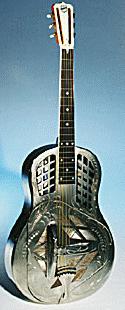
-
But there are some differences in the old and new models:
- Body Material: All new National nickel-plated bodies are made of Brass, not German Silver (most original 1928-1940 nickel-plated vintage models except the Style O, 35 and 97 were German Silver, not brass). Sorry, but brass just doesn't sound nearly as good as German Silver, or even steel bodies. This is especially a problem on the Tricone reissues (except for the "polychrome" tricone model).
- Neck Finish and Feel: National now uses a water-based paint because of California environmental issues. This makes the neck feel significantly different than vintage Nationals with extremely thin lacquer finishes. Also the reissues have a flatter neck profile, unlike the "baseball bat" vintage neck profiles and "V" neck profiles.
- Body Finish: National today can not recreate the original "Frosted Duco" vintage National Duolian finish. This finish style formula was patented in the 1930's, and has apparently been lost. I know of no one on this planet that can recreate that finish today.
- Styling: New Nationals have a different style and look (especially the single cone models). They just look and feel new, especially the necks.
- Truss Rods: New Nationals all have adjustable truss rods. I know, this is technically good; the original models had either no truss rod, or a non-adjustable truss rod. But I'm sorry, seeing a truss rod on new Nationals just isn't right (call me a purist).
- 14 Frets Clear: You can't buy a new National metal body resonator model with 14 frets clear of the body. All single cone metal body reissues are based on the 1933-1934 twelve fret, rolled "F" hole single cone body style. Of course this applies to tricone reissues too as original tricones were never available in 14 fret versions.
-
Admittedly, these are small details. And the market must also
feel they are small details since the demand and price for
vintage Nationals has dropped so much. Check out National's
home page for more details on new Nationals:
http://www.nationalguitars.com/instruments.html
-
After WW2, National made many non-resonator guitar models.
To understand the how and why of this, a
short history lesson in required.
In 1935 National and Dobro merged to form the National-Dobro Company. Within a year they moved the company's offices and production to Chicago. There National-Dobro concentrated on electric instruments and amplification, rather than the resonator guitars for which they were known. In 1941, the Chicago Musical Instrument Company (CMI) gained exclusive distribution rights to National's electric instruments. Remember this was the early age of electric guitars, and electrics basically made National's resonator instruments obsolete. But with the December 1941 attacks on Pearl Harbor, National's guitar production was ceased by government legislation and its workforce re-trained for War-related manufacturing. In 1943 the remaining stock holders of National-Dobro were bought out by Vic Smith, Al Frost, and Louis Dopyera, who formed the Valco Manufacturing Corporation (Valco is an acronym for Vic, Al, and Louis). When the War ended, Valco re-vested itself into the musical instrument industry and built instruments and amplifiers throughout the 40s, 50s and most of the 1960s.
At the same time WW2 brought a similar fate to Gibson's factory, where as much as 90% of that company's production went toward the war-effort. In 1944 CMI bought Gibson, and after WW2, this set up a link between Valco and Gibson. Until the late 1950s some National-branded instruments used Gibson body parts. So "National" acoustic and electric models could have a National neck and a Gibson body! This can be seen, for example, on National/Valco models that use a J-45 acoustic guitar body, but have a National neck. Or a Gibson ES-175 body with a National neck and National pickup system. All these National models will have the post-war National/Valco metal serial number plate and are considered "Nationals" (not Gibsons).
Back to the Table of Contents
|
Vintage National Tenor Guitars: though these 4 string
tenor guitars are pretty to look at, they are fairly
useless as instruments today. Tenors were marketed
during the late 1920s and 1930s to get banjo players
to convert to (the increasingly popular) guitar. Not
much need for that today, hence their collectibility is
very limited.
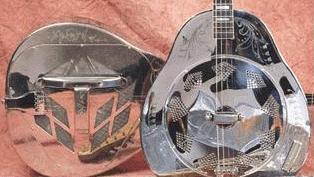
Serial numbers
(How to Find the Year)
National Vintage Serial Numbers
-
National/Valco serial numbers provide the easiest way to find the
year for a particular instrument.
Serial numbers courtesy of Bob Brozman and his book "National Resonator Instruments", 1993.
Serial Numbers 1927-1935.
-
From 1927 to 1935, Natonal used a different serial number system for each
model. On single cone steel body models, the number is stamped on the top
of the peghead. The single cone exception is the Style O, which are usually
stamped into the body by the endpin.
roundneck tri-cone.

-
On roundneck Tricone models, the serial number is stamped into the
body by the endpin until serial number 2400. On squareneck Tricones,
the serial number is stamped
into the back of the metal neck near the peghead up until serial number
2400. On all Tricones after serial number 2400, the number is stamped at
the top of the peghead.
Note most of the serial numbers provided are from actual instruments. The year of manufacturer was deduced by evaluating catalog specs for the year.
-
Square Neck Tricones, 1927-1934.
Number range Year ------------ ---- 100 388 1927 393 1136 1928 1139 1886 1929 1891 2294 1930 2301 2571 1931 2601 2682 1932 2833 3315 1933 3323 1934Round Neck Tricones, 1927-1930.
Number range Year ------------ ---- 0100 0141 1927 0145 0748 1928 0781 01002 1929 01004 1930Note: round neck Tricones use the S-series numbers after 1930.
1934 Style O "S" series serial number.
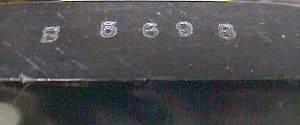
S-series: Style O and roundneck Tricones, 1930 to 1934.
Number range Year ------------ ---- S1 S2195 1930 S2145 S2785 1931 S2788 S3991 1932 S4035 S4393 1933 S5001 S6205 1934Note: S5438 = start of 14 fret Style O instruments.
Tenor Nickel Plated Models.
Range Model Year ------- ----- ---- 100-600 Tricone 1928 600-850 Pear shape 1 cone 1929 850-1400 Guitar shape 1 cone 1929-1934
Mandolin, Ukes.
Range Model Year ------- ----- ---- 100-600 Mandolin 1928-1934 100-400 Uke 1928-1934
Don Models.
Number range Year ------------ ---- X27 X133 1934
Wood body Triolians with serial numbers (1929 only).
Number range Year ------------ ---- 500 1626 1929Early Metal body Triolians (1929 only).
Number range Year ------------ ---- 0100 0209 1929 (yellow)
1929 bakelite neck Triolian with
"A" series serial number.
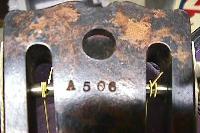
Bakelite neck Triolians 1929-1930.
Number range Year ------------- ---- A10 A1650 1929 A1651 A1814 1930Polychrome Triolians 1930-1934.
Number range Year ------------- ---- 0100 0209 1929 (yellow) 1P 2266P 1930-1934, 12 fret Polychrome Triolians. 2267P 2500P 1934, 14 fret Polychrome Triolians.Walnut Sunburst Triolians 1930-1934.
Number range Year ------------- ---- 1W 1800W 1930 1801W 2550W 1931 2551W 3200W 1932 3201W 3350W 1933, 1934C-series Green/Gray Duolians 1931-1935.
Number range Year ------------- ---- C1 C6000 1931, 1932 C6001 C7250 1933 C7251 C9700 1934, 1935E-series Duolians (1934 only).
Number range Year ------------- ---- E7200 E7899 1934No prefix Duolians 1935-1936.
Number range Year ------------ ---- 899 3769 1935 3770 6750 1936R series, Sears-Roebuck Duolians (1931 only).
-
Five large drilled areas on coverplate instead of the usually 9.
Number range Year ------------ ---- R1 R600 1931N prefix (1935 only).
O prefix Duolians (1931 only).
Number range Year ------------ ---- O500 O1750 1931K prefix El Trovador wood body (1933 only).
Number range Year ------------ ---- K300 K555 1933T prefix Trojan wood body 1934-1937.
Number range Year ------------ ---- T100 T2999 1934-1936 T3000 1937Z prefix, other wood body Nationals 1934-1936.
Number range Year ------------ ---- Z100 Z2050 1934,1935 Z2051 1936Serial Numbers, 1936 to 1941 (Chicago series).
-
From 1936 to 1942, a single series is used for all instruments with
different prefix letters.
A-series 1936-1938 (not to be confused with A-series bakelite neck Triolians).
Number range Year ------------ ---- A1 A999 1936 A1000 A6210 1937 A6211 A8550 1938
1937 Duolian with "B" series serial number.
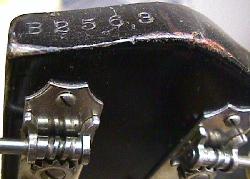
-
B-series 1936-1937.
Number range Year ------------ ---- B1 B1475 1936 B1476 B3550 1937C-series 1937-1939 (not to be confused with C-series Duolians of 1931-1935).
Number range Year ------------ ---- C100 C1475 1937 C1476 C4650 1938 C4651 C5750 1939L-series 1938-1939.
Number range Year ------------ ---- L9800 L10000 1938 L10070 L10199 1939
1934 14 fret open peghead Duolian with
gold frosted Duco finish. This was a special
series "G" serial number that went from
G100 to G200 (approximately). These special
"G" serial numbers were different from
the 1940-1941 "G" series serial numbers.

G-series 1940-1943.
Number range Year ------------ ---- G-100 G-199 1940 200G 4450G 1940, 1941 4451G and up 1942, 1943-1947The serial number plate as used
on all Valco-made National guitars
from 1940 to 1964. This "X" serial
number designates this as 1956.
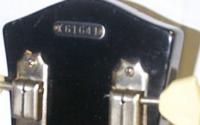
Serial Number Plates 1940-1964.
-
Beginning in 1940, National/Valco serial numbers were on a small
oblong metal plate (brass or aluminum). This plate was tacked to the back
of the neck with two small brass nails.
The following serial numbers apply to all
Valco-made National instruments, including lapsteels and guitars.
These plates were also put on amplifiers.
All Valco-made instruments were numbered this way till 1964. Valco also
made instruments for Sears (Silvertone),
Montgomery Wards (Airline), Gretsch, Oahu and others. These are numbered
with the same metal tag system.
Number range Year ------------ ---- G suffix 1940-1942 V100 V7500 1947 V7500 V15000 1948 V15000 V25000 1949 V25000 V35000 1950 V35000 V40000 1951 X100 X7000 1951 X7000 X17000 1952 X17000 X30000 1953 X30000 X43000 1954 X43000 X57000 1955 X57000 X71000 1956 X71000 X85000 1957 X85000 X99000 1958 T100 T5000 1958 T5000 T25000 1959 T25000 T50000 1960 T50000 T75000 1961 T75000 T90000 1962 G100 G5000 1962 T90000 T99000 1963 G5000 G15000 1963 G15000 G40000 1964"1-" foil serial number, as used from 1964 to 1968.
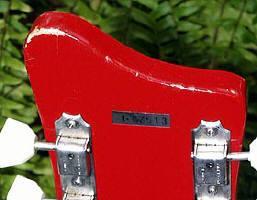
Serial Number Stickers 1964-1968.
-
In 1964, National/Valco replaced the metal serial number plate with a
rectangular foil sticker. Stickers have numeric prefixes.
Prefix Year Range ------ ---------- 1 1964 to early 1968 2 early to mid 1968
Back to the Table of Contents
1928 National Tricone style 4 roundneck
![]()
Tricone Roundneck and Squareneck Metalbody vintage guitars, 1927-1942.
-
German silver body (solid nickel alloy with nickel plating), three or "tri"
resonator cones with two cones on the bass side, one cone on the treble
side, T-shaped bridge cover and handrest, grid pattern soundholes on upper
body, Hawaiian squareneck or Spanish roundneck styles, 12 frets clear of
the body, flat fingerboard radius, mahogany neck on Spanish model, metal
neck with mahagony headstock on Hawaiian model, bound
single layer ebony fingerboard, slotted peghead.
Style 1, 1 1/2: plain body, early examples with unbound fingerboard, dot fingerboard
inlays. After 1930, "wriggly" lines engraved around outer edge of body.
Note this is sometimes refered to as a "Style 1 1/2". Available 1927-1942.
Collectibility Rating: Squareneck: D-, Roundneck: B-.
Style 2, 2 1/2: Wild Rose engraving, no engraving on coverplate, dot fingerboard
inlays. Note some 1927-1929 examples have roses engraved on the coverplate.
This is sometimes refered to as a "Style 2 1/2". Available 1927-1942.
Collectibility Rating: Squareneck: D, Roundneck: B.
-
Style 3: Lily of the Valley engraving, diamond shaped fingerboard inlays,
some with ebony peghead veneer and pearl logo, some with celluloid peghead
veneer and engraved logo. Clear pickguard added 1936. Available 1928-1942.
Collectibility Rating: Squareneck: C, Roundneck: B+.
On the back you can just barely see the "Lute player" sandblasting, and
the remains of the enameled air brushed color.
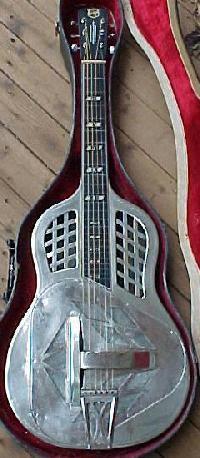
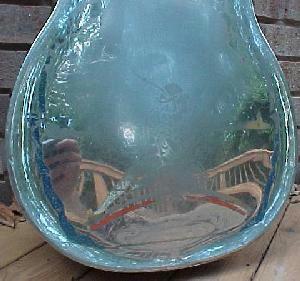
Style 4: Chrysanthemum engraving, diamond shaped fingerboard inlays,
some with ebony peghead veneer and pearl logo, some with celluloid peghead
veneer and engraved logo. Clear pickguard added 1936. Available 1928-1940.
Collectibility Rating: Squareneck: C, Roundneck: A.
Style 35: Known as the "Lute Player" model.
Brass body with nickel plating, back sand blasted etching of
Renaissance musician under willow tree, palm trees sand blasted on front
and sides, airbrushed enamel coloring over
sand blasting, maple neck, bound ebonoid fingerboard on squareneck model,
bound rosewood fingerboard on roundneck model, dot fingerboard inlays,
solid peghead. Enamel coloring discontinued 1939. Available 1936-1942.
Collectibility Rating: Squareneck: C-, Roundneck: B- (a brass body makes
for a lower rating).
Style 97: Brass body with nickel plating, back sand blasted etching of
surfer, airbrushed enamel coloring over sand blasting, maple neck on
squareneck, mahogany neck on roundneck, ebonoid peghead veneer, slotted
peghead with point at top, sheild logo with 3 vertical line. Clear pickguard
added 1937. Available 1936-1940.
Collectibility Rating: Squareneck: C-, Roundneck: B- (a brass body makes
for a lower rating).
Style M-3 (Marino):
Introduced in 1937, this plain nickel plated brass
body model has a square neck (Hawaiian). By 1942 the body is no long
nickel plated but is instead painted with a oak looking wood grain
finish. Discontinued by 1943. Almost all were made with square necks.
Collectibility Rating: Squareneck: C-, Roundneck: B+ (a brass body makes
for a lower rating, but roundneck scores high because of the rarity).
original round neck M-3 guitar may be the only one ever made. Note
the oak colored painted woodgrain body.
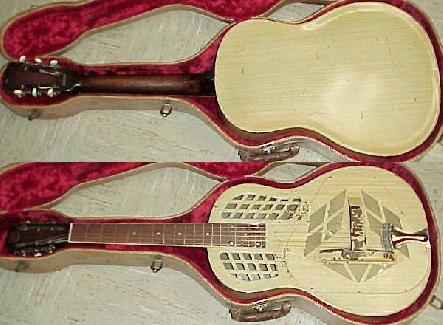
Back to the Table of Contents
1940 National Style O with paddle headstock

Style O Metalbody vintage Resonator, 1930-1941.
Collectibility Rating: Squareneck: D-, Roundneck: C (a very common model
and a brass body make for a lower rating).
-
Single cone resonator, nickel plated body with sand blasted Hawaiian scene
on back and palm trees on front and solid area on sides, round shoulder,
upper F-holes, round neck, dot inlay fingerboard, bound ebony
fingerboard. There were 6 different variations in the sand blasted Hawaiian
scene, and 8 total Style O variations if you include body changes. Four of
the six sand blasting variations were used on the 12 fret models.
- Steel body, nickel plated.
- Flat cut f-holes.
- 12 frets clear of the body.
- Slotted peghead.
- Maple round neck.
- Flat fingerboard radius.
- Resonator cover with small holes drilled in diamond patterns.
- "National" decal on peghead.
- Front scene: 1 palm tree with clear areas in the trunk's center around resonator's treble side, border. Back scene has two palm trees.
1930 Style O Introduction specs:
-
1931 Style O specs:
- Brass body used instead of steel, nickel plated.
- Front scene: NO border.
- Brass resonator cover plate, nickel plated.
- Rolled edge f-holes.
- Resonator cover with four embossed radiating lines added.
- Square mahogany neck available.
- Back scene has one palm tree.
- 14 frets clear of the smaller body.
- 10 inch fingerboard radius.
- Diamond shape resonator cover cutouts shaped like "crow feet" (though the 1933 style cover plate is also used till 1936).
- Scene: simplier front & back Hawaiian scene with two palm trees on front (one on each side of the resonator, and the trunks no longer have the clear areas).
- Solid peghead with arched "National" logo in celluloid letters.
- Some models with Mahogany necks.
- Scene: reversed 1934 scene and further simplified.
- Clear or flowered white pickguard added.
- Palm trees etched on side of body.
- "National" etched into ebonized black peghead veneer.
- Slotted parallelogram fingerboard inlays.
- Enlarged "paddle" peghead.
- Metal National sheild logo.
1932 Style O specs:
1933 Style O specs:
Late 1934 Style O specs:
1936 Style O specs:
1937 Style O specs:
1939 Style O specs:
1940 Style O specs:
Style O Discontinued 1941.
Back to the Table of Contents
Style N Metalbody vintage Resonator, 1930-1932.
Collectibility Rating: Roundneck: B (a german silver body makes for a
higher rating, even though this model is plainer than a Style O).
-
National's highest quality single cone resonator, German silver body with
nickel plating and no etching or sand blasting, round shoulder, upper
F-holes, pearloid peghead veneer with engraved National logo, mahagony
round neck, dot inlay fingerboard, bound ebony fingerboard, 12 frets clear
of the body, slotted peghead.
Replaced in 1934 by the 14 fret Don model.
Back to the Table of Contents
1934-1936 Don Style 1. Note the
engraving on the handrest and the
celluloid peghead overlay.

Don Metalbody vintage Resonator, 1934-1936.
-
National's highest quality single cone resonator replacing 12 fret Style N
model, German silver body with
nickel plating, round shoulder, upper F-holes, pearloid peghead veneer with
engraved National logo, round mahogany neck, slotted peghead, bound ebony
fingerboard, 14 frets clear of the body, "DON" engraved on handrest.
Style 1 Don: plain body except for engraved borders.
Collectibility Rating: Squareneck: D, Roundneck: B.
Style 2 Don: "modernistic" body engraving somewhat resembling sheaves of
flowers, diamond fingerboard inlays.
Collectibility Rating: Squareneck: D+, Roundneck: B+.
Style 3 Don: "conventional" flower-style body engraving, diamond
fingerboard inlays.
Collectibility Rating: Squareneck: C, Roundneck: A.
Back to the Table of Contents
1937 Duolian in "piano" finish
(a dark painted wood grain).
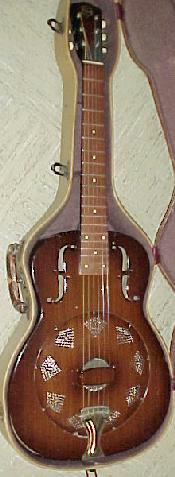
Duolian Metalbody vintage Resonator, 1930-1938.
Collectibility Rating: Squareneck: D-, Roundneck: C (a great sounding
single cone National, but they made TONS of them since they were only
$32.50 brand new).
-
Single cone resonator, Steel body, round shoulder, upper F-holes, unbound
fingerboard, dot fingerboard inlays.
- Steel body with flat cut f-holes.
- Ebonized maple fingerboard with no binding.
- Round mahogany neck.
- 12 frets clear of the body.
- Slotted peghead.
- Flat fingerboard radius.
- "National Duolian" decal on peghead.
- "Frosted Duco" finish with crystal-like texture, color varies from grey to green to black.
- "Duolian" stamped in face of peghead replacing decal.
- Rolled edge F-holes.
- Square neck available special order.
- 14 frets clear of the smaller body.
- Basswood neck replaces mahogany.
- 10 inch fingerboard radius.
- "Duolian" decal replacing stamped "Duolian" name in peghead.
1930 Duolian Introduction specs:
1931 Duolian specs:
1933 Duolian specs:
Late 1934 Duolian specs:
-
1936 Duolian specs:
- Solid peghead.
- Rosewood or "Red bean" fingerboard.
- "Piano" body finish, simulating walnut grain.
- Pickguard added. Sometimes black, sometimes wood grain with diagonal stripes.
1937 Duolian specs:
1938 Duolian specs:
Duolian catalong discontinued 1938, replaced by the Collegian. But later 1939-1941 National Duolians were made.
Back to the Table of Contents
1930 National Triolian Polychrome
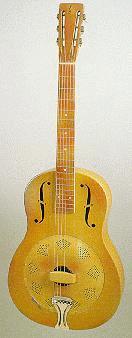
Triolian vintage Resonator, 1928-1938.
Collectibility Rating: Metal body Squareneck: D-, Sunburst Metal body
Roundneck: C, Polychrome Metal body Roundneck: C+
(At $45 new, it was fancier than the $32.50 Duolian, but still very common.
And the maple neck doesn't sound as good as the mahogany neck Duolian.
-
Single cone resonator, round shoulder, upper F-holes, bound single layer
fingerboard, dot fingerboard inlays.
- Wood body.
- Maple fingerboard, no binding.
- Round maple neck.
- 12 frets clear of the body.
- Slotted peghead.
- Flat fingerboard radius.
- "National Triolian" decal on peghead.
- Multi-hued Polychrome tan-yellow finish with pink & purple highlights.
- Opaque neck & fingerboard finish same as body.
- Decal on back was first a flower bouquet, then changed to a hula girl. Last few wood models have stenciled Hawaiian scene.
Late 1928 Wood Body Triolian Introduction specs:
-
1929 Metal Body Triolian specs:
- Steel metal body.
- Maple fingerboard with binding.
- Walnut sunburst finish or Polychrome tan-yellow finish with red & blue highlights.
- Sunburst models have ebonized fingerboard, Polychrome fingerboard finish is clear with faint red & blue highlights.
- Stenciled black Hawaiian scene with orange sun on back.
- Bakelite neck used 1929-1930 but discontinued due to warping & cracking (no binding).
- Flat cut f-holes.
- Polychrome body finish changes to pea green with faint highlights.
- Polychrome fingerboard finish changes to ebonized black.
- Rolled edge F-holes.
- Square neck available special order.
- 14 frets clear of the smaller body.
- Round basswood neck replaces maple.
- 10 inch fingerboard radius.
- Solid peghead.
- Polychrome and sunburst body finishes discontinued.
- "Piano" body finish, simulating rosewood grain.
- Rosewood or "Red bean" fingerboard.
- Pickguard added. Sometimes black, sometimes wood grain with diagonal stripes.
1930 Triolian specs:
1933 Triolian specs:
Late 1934 Triolian specs:
1936 Triolian specs:
1937 Triolian specs:
1938 Triolian specs:
Triolian catalog discontinued 1938. Replaced by the Collegian. But later 1939-1941 National Triolians were made.
Supro Collegian vintage Resonator, 1939-1941.
Collectibility Rating: Metal body Roundneck: C+ (At $35 new, it was basically a pale yellow colored Duolian with a different coverplate. Sold under the Supro brand name (but still sometimes has the National nameplate), this model replaced the Duolian and Triolian models in 1939. Discontinued in 1941.)
-
Single cone resonator, unbound
fingerboard, dot fingerboard inlays, 14 frets clear of the body,
Supro brand name on peghead,
pale yellow color, resonator coverplate with large 1/2" holes (not
used on any other National resonator models).
Back to the Table of Contents
National vintage Wood Body Resonators, 1928-1942.
-
Triolian.
The first wood body resonator was the Triolian in late 1928. By 1929, this model converted to a metal body instrument. The very first wood body Triolians had a tricone resonator system. Less than 10 of these examples were produced. Much like the metal body version, the wood body Triolian has a single cone resonator, round shoulder, upper F-holes, bound single layer fingerboard, dot fingerboard inlays, 12 frets clear of the body.
Collectibility Rating: Roundneck: D (the earliest single cone, but not too many collectors want wood body Nationals).
Rosita.
Maple veneer body probably made by Harmony, lyre-shaped holes in upper body,
trapeze tailpiece, bound top and back, 14 frets clear of the body,
ebonized fingerboard, dot fingerboard inlays, slotted peghead, 2-tone
mahogany finish, round or square neck. In 1937 F-holes replaced the lyre
shaped holes in the upper body. Available 1933 to 1939.
Collectibility Rating: Squareneck: D--, Roundneck: D (not too many
collectors want wood body Nationals).
El Trovador.
Body made by Kay, mahogany top, 2 piece matched mahogany back, upper F-holes,
triple bound top and back, trapeze tailpiece, 12 frets clear of the body,
bound fingerboard, dot fingerboard inlays, slotted peghead, serial number
beginning with "K". Available 1933 for 8 months only.
Collectibility Rating: Roundneck: D-- (not too many
collectors want wood body Nationals).
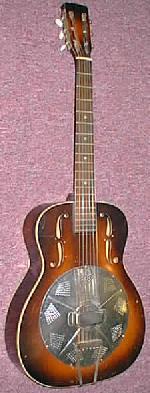
-
Trojan.
Maple veneer body, upper F-holes, trapeze tailpiece, bound top, 14 frets clear of the body, slotted peghead, shaded walnut finish. Introduced 1934.
Collectibility Rating: Roundneck: D- (not too many collectors want wood body Nationals).
In 1937 Trojan specs changed to Dobro-type tailpiece, ebonoid pickguard with stripes and letter "N", bound top and back, rosewood fingerboard, solid peghead, bound ebonoid peghead veneer. Discontinued 1942.
Estralita.
Mahogany top, 2 piece matched mahogany back, upper F-holes, 4-ply binding
around coverplate, 4-ply binding on top and back, unbound fingerboard,
14 frets clear of the body, varied pattern fingerboard inlay, solid
peghead, shaded brown finish. Available 1934 to 1942.
Collectibility Rating: Roundneck: D+ (a fancier wood body National with
some unusual features).
-
Havana.
Spruce top, upper F-holes, roundneck or squareneck, bound fingerboard, dot fingerboard inlays, ebonoid peghead veneer, natural top finish, sunburst back finish. Available 1938 to 1942.
Collectibility Rating: Roundneck: D+ (a fancier wood body National with some unusual features).
Aragon de Luxe.
Archtop body made by Kay, spruce top, maple back and sides, bound upper
F-holes, radial pattern wood coverplate with semi-rectangular holes in
groups of 3, board plate tailpiece, clear pickguard, triple bound top and
back, bound rosewood fingerboard, double parallelogram fingerboard inlays,
rosewood peghead veneer, bound peghead, chrome plated metal parts,
light brown sunburst finish. Available 1939 to 1942.
Collectibility Rating: C (an archtop resonator National, very
strange).
Back to the Table of Contents
IMPORTANT WARNING: These 1960s map shaped guitars can have a fatal flaw; there is NO adjustable
truss rod! Hence if their neck is warped, the map guitar in question is essentially worthless. In
addition, because of the unique shape of the body, having the original case is a *big* deal! Without
the original case, the map-shaped guitar is worth far less.
The bridge on a 1962 Glenwood 99. Note the three metal slugs going from clear plexiglass bridge
base to the rosewood saddle. These slugs are the pickup poles for the internal pickup,
mounted inside the clear plexiglass bridge base (the gray pickup can be seen here inside
the clear bridge base). This bridge mounted pickup gives a somewhat acoustic
sound, and was used on the 99, 98, 88, 84, 77, and 75 models.
1962 Glenwood 99 with vibrato.
1962 Glenwood 99 introduction specs:
1963 Glenwood 99 specs:
1964 Glenwood 99 specs:
1965 Glenwood 99 discontinued.
Glenwood 98 vintage Map electric, 1962-1965.
1962 Glenwood 98 introduced.
1963 Glenwood 98 specs:
1964 Glenwood 98 specs:
1965 Glenwood 98 discontinued.
1962 Glenwood 95.
1962 Glenwood 95 introduced.
Val-Pro 88, Newport 88 vintage Map electric, 1962-1965.
1962 Val-Pro 88 introduced.
1963 Newport 88 specs:
1965 Newport 88 discontinued. But some Newport models
were assembled from leftover parts (some with Italian hardware)
for bankruptcy auction in 1968.
1964 National Newport 84 in seafoam green.
1962 Val-Pro 84 introduction specs:
1963 Newport 84 specs:
1965 Newport 84 discontinued. But some Newport models
were assembled from leftover parts (some with Italian hardware)
for bankruptcy auction in 1968.
1964 Newport 82 with vibrato handle missing.
1962 Val-Pro 82 introduction specs:
1963 Newport 82 specs:
1965 Newport 82 discontinued. But some Newport models
were assembled from leftover parts (some with Italian hardware)
for bankruptcy auction in 1968.
Westwood 77 vintage Map electric, 1962-1965.
1962 Westwood 77 introduced.
Westwood 75 with wood body.
1962 Westwood 75 introduced.
Westwood 72 vintage Map electric, 1962-1965.
1962 Westwood 72 introduced.
1931: Smaller uke body size used.
Silver Ukes.
1936: Styles 1 and 2 discontinued. Only Style 3 available.
Triolian (painted) Ukuleles.
Map-shaped Electric Models

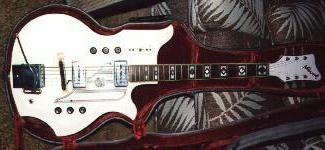
Glenwood 99 vintage Map electric, 1962-1965.
Collectibility Rating: C+
Molded res-o-glas (fiberglass) body in the shape of a U.S. map with upper pointed treble bout corresponding
to Florida. Asymmetrical peghead, longer on treble side. Two standard
pickups and one built-into-the-bridge pickup, three knobs and 3-way slotted switch
on bass side, three knobs on treble side.
Diamond enclosed by blocks ("butterfly") fingerboard inlays,
peghead veneer edges beveled to show side black line, tailpiece with stairstep sides,
back of neck is white.
Back to the Table of Contents
Collectibility Rating: C+
Molded res-o-glas (fiberglass) body in the shape of a U.S. map with upper
pointed treble bout corresponding
to Florida. Asymmetrical peghead, longer on treble side. Two standard
pickups and one built-in-the-bridge pickup, three knobs and 3-way slotted switch
on bass side, three knobs on treble side, Bigsby vibrato, chrome plated parts.
Diamond enclosed by blocks ("butterfly") fingerboard inlays,
peghead veneer edges beveled to show side white/black/white lines, black finish
on back of neck, pearl white body finish.
Back to the Table of Contents
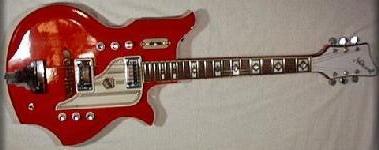
Glenwood 95 vintage Map electric, 1962-1965.
Collectibility Rating: C+
Molded res-o-glas (fiberglass) body in the shape of a U.S. map with upper pointed treble bout corresponding
to Florida. Asymmetrical peghead, longer on treble side. Two standard
pickups, three knobs and 3-way slotted switch
on bass side, three knobs on treble side. Plate tailpiece with stairstep sides,
chrome plated parts.
Peghead veneer edges beveled to show side black line,
diamond enclosed by blocks "butterfly" fingerboard inlays,
vermilion red body finish.
1965 Glenwood 95 discontinuded.
Back to the Table of Contents
Collectibility Rating: D
Molded res-o-glas (fiberglass) body in the shape of a U.S. map
with upper pointed treble bout corresponding
to Florida. Asymmetrical peghead, longer on treble side. Two standard
pickups and one built-into-the-bridge pickup, 6 knobs and 3-way slotted switch
on treble side, chrome plated parts.
Quarter circle fingerboard inlays,
ravin black body finish.
Back to the Table of Contents
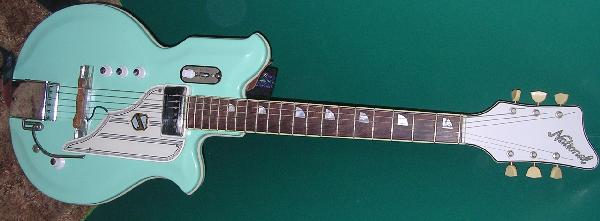
Val-Pro 84, Newport 84 vintage Map electric, 1962-1965.
Collectibility Rating: D
Molded res-o-glas (fiberglass) body in the shape of a U.S. map
with upper treble bout corresponding
to Florida. Asymmetrical peghead, longer on treble side. One standard
pickup and one built-in-the-bridge pickup, 3 knobs and 3-way slotted switch
on treble side, chrome plated parts.
Quarter circle fingerboard inlays.
Back to the Table of Contents
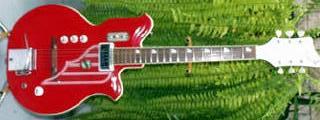
Val-Pro 82, Newport 82 vintage Map electric, 1962-1965.
Collectibility Rating: D
Molded res-o-glas (fiberglass) body in the shape of a U.S. map
with upper treble bout corresponding
to Florida. Asymmetrical peghead, longer on treble side. One standard
pickup, chrome plated parts.
Quarter circle fingerboard inlays.
Back to the Table of Contents
Collectibility Rating: D-
Wood body heavily routed from the back in the shape of a U.S. map
with upper treble bout corresponding
to Florida. Asymmetrical peghead, longer on treble side. Available with one pickup, or two standard
pickups and one built-into-the-bridge pickup, 6 knobs on bass side, 3-way slotted switch,
1 knob on treble side, clear Lucite bridge bass, bound fingerboard,
chrome plated parts. Block fingerboard inlays, cherry finish.
1965 Westwood 77 discontinued. But some Westwood models
were assembled from leftover parts (some with Italian hardware)
for bankruptcy auction in 1968.
Back to the Table of Contents

Westwood 75 vintage Map electric, 1962-1965.
Collectibility Rating: D-
Wood body heavily routed from the back in the shape of a U.S. map
with upper treble bout corresponding
to Florida. Asymmetrical peghead, longer on treble side. One standard
pickup and one built-into-the-bridge pickup, 3 knobs on bass side, 3-way slotted switch
on treble side, chrome plated parts.
Block fingerboard inlays, cherry to black sunburst finish.
1965 Westwood 75 discontinued. But some Westwood models
were assembled from leftover parts (some with Italian hardware)
for bankruptcy auction in 1968.
Back to the Table of Contents
Collectibility Rating: D-
Wood body heavily routed from the back in the shape of a U.S. map
with upper treble bout corresponding
to Florida. Asymmetrical peghead, longer on treble side. One standard
pickup, 3 knobs on treble side, 3-way slotted switch
on bass side, chrome plated parts.
Block fingerboard inlays, blond/ivory finish.
1965 Westwood 72 discontinued. But some Westwood models
were assembled from leftover parts (some with Italian hardware)
for bankruptcy auction in 1968.
Back to the Table of Contents
National vintage Ukulele Resonator, 1928-1940.
Introduced in 1928, all National Ukes have a guitar-shaped body, single
cone resonator, no upper body holes, 5 diamond shaped hole clusters in
coverplate.
Introduced in Style 1 (plain, no engraving), Style 2 (Rose engraving), and
Style 3 (Lily of the Valley engraving). Note there is no Style 4 Uke.
Silver uke pegheads have a sculped top edge, conpared to painted
ukes which have a straight top peghead edge.
1939: Style 3 discontinued.
National also sold Triolian ukes painted like their guitars. Available
finishes were Polychrome (yellowish color with black Hawaiian scene stenciled
on back), Walnut Sunburst. Painted ukes have a straight top edge peghead,
compared to silver ukes which is sculped.
Introduced in 1930, discontinued in 1940.
Back to the Table of Contents
Copyright 1995-2002 all rights reserved.
